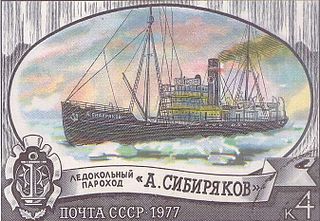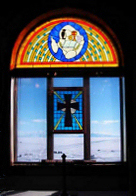Related Research Articles

The history of Antarctica emerges from early Western theories of a vast continent, known as Terra Australis, believed to exist in the far south of the globe. The term Antarctic, referring to the opposite of the Arctic Circle, was coined by Marinus of Tyre in the 2nd century AD.

Sir Douglas Mawson OBE FRS FAA was an Australian geologist, Antarctic explorer, and academic. Along with Roald Amundsen, Robert Falcon Scott, and Sir Ernest Shackleton, he was a key expedition leader during the Heroic Age of Antarctic Exploration.

Marie Byrd Land is an unclaimed region of Antarctica. With an area of 1,610,000 km2 (620,000 sq mi), it is the largest unclaimed territory on Earth. It was named after the wife of American naval officer Richard E. Byrd, who explored the region in the early 20th century.
A British expedition to Graham Land led by John Lachlan Cope took place between 1920 and 1922.

A number of governments have set up permanent research stations in Antarctica and these bases are widely distributed. Unlike the drifting ice stations set up in the Arctic, the Research stations of the Antarctic are constructed either on rock or on ice that is fixed in place.

The Scottish National Antarctic Expedition (SNAE), 1902–1904, was organised and led by William Speirs Bruce, a natural scientist and former medical student from the University of Edinburgh. Although overshadowed in terms of prestige by Robert Falcon Scott's concurrent Discovery Expedition, the SNAE completed a full programme of exploration and scientific work. Its achievements included the establishment of a manned meteorological station, the first in Antarctic territory, and the discovery of new land to the east of the Weddell Sea. Its large collection of biological and geological specimens, together with those from Bruce's earlier travels, led to the establishment of the Scottish Oceanographical Laboratory in 1906.

The DiscoveryExpedition of 1901–1904, known officially as the British National Antarctic Expedition, was the first official British exploration of the Antarctic regions since the voyage of James Clark Ross sixty years earlier (1839-1843). Organized on a large scale under a joint committee of the Royal Society and the Royal Geographical Society (RGS), the new expedition carried out scientific research and geographical exploration in what was then largely an untouched continent. It launched the Antarctic careers of many who would become leading figures in the Heroic Age of Antarctic Exploration, including Robert Falcon Scott who led the expedition, Ernest Shackleton, Edward Wilson, Frank Wild, Tom Crean and William Lashly.
The Soviet Antarctic Expedition was part of the Arctic and Antarctic Research Institute of the Soviet Committee on Antarctic Research of the Academy of Sciences of the USSR.
The First Soviet Antarctic Expedition was led by Mikhail Somov; his scientific deputy was V. G. Kort. The expedition lasted from 30 November 1955 to 1957 and involved 127 expedition members and 75 crew members.
The Third Soviet Antarctic Expedition (1957–59) was led by Yevgeny Tolstikov on the continent and included Czech future astronomer Antonín Mrkos; the marine expedition on the Ob was led by I V Maksimov.

The Pole of Inaccessibility Research Station is a defunct Soviet research station in Kemp Land, Antarctica, at the southern pole of inaccessibility as defined in 1958 when the station was established. Later definitions give other locations, all relatively near this point. It performed meteorological observations from 14 to 26 December 1958. The Pole of Inaccessibility has the world's coldest year-round average temperature of −58.2 °C (−72.8 °F).
Soviet and Russian staffed drifting ice stations are research stations built on the ice of the high latitudes of the Arctic Ocean. They are important contributors to exploration of the Arctic. The stations are named North Pole, followed by an ordinal number: North Pole-1, etc.
The Heroic Age of Antarctic Exploration was an era in the exploration of the continent of Antarctica which began at the end of the 19th century, and ended after the First World War; the Shackleton–Rowett Expedition of 1921–1922 is often cited by historians as the dividing line between the "Heroic" and "Mechanical" ages.

A. Sibiryakov was a Soviet icebreaker which was active in the Russian Arctic during the 1930s. She was built in 1909 in Glasgow and was originally the Newfoundland sealing steamer Bellaventure. After being purchased by Russia in 1916, she was renamed A. Sibiryakov. Her Russian name was chosen in honour of Aleksandr Mikhaylovich Sibiryakov, an Imperial Russian gold mine proprietor. Sibiryakov financed explorations to Siberia, such as Adolf Erik Nordenskiöld's, and also took part in some expeditions of his own.

Christian buildings are the only religious buildings on the continent of Antarctica. Although they are used mostly for Christian worship, the Chapel of the Snows has also been used for Buddhist and Baháʼí Faith ceremonies. Some of the early religious buildings are now protected as important historical monuments.

The Order "For Naval Merit" is a state decoration of the Russian Federation bestowed for excellence in military or economic maritime endeavours. It was established on February 27, 2002 by Decree of the President of the Russian Federation № 245. Its statute was amended by presidential decree № 1099 of September 7, 2010.

Warpasgiljo Glacier is a valley glacier about 25 mi (40 km) long, flowing West to Sulzberger Ice Shelf between the Swanson Mountains on the North and Mounts Rea and Cooper on the South, in the Edsel Ford Ranges of Marie Byrd Land. This glacier was discovered by and named for the four Geological Party Expedition members of the West Base of the United States Antarctic Service (USAS), in aerial flights and from ground surveys in November–December 1940, as part of the Antarctic Expedition of 1939-1941 led by Rear Admiral Richard E. Byrd.

Andrey Petrovich Kapitsa was a Russian geographer and Antarctic explorer, discoverer of Lake Vostok, the largest subglacial lake in Antarctica. He was a member of the Kapitsa family, a scientific dynasty in Russia.

The Ross expedition was a voyage of scientific exploration of the Antarctic in 1839 to 1843, led by James Clark Ross, with two unusually strong warships, HMS Erebus and HMS Terror. It explored what is now called the Ross Sea and discovered the Ross Ice Shelf. On the expedition, Ross discovered the Transantarctic Mountains and the volcanoes Erebus and Terror, named after his ships. The young botanist Joseph Dalton Hooker made his name on the expedition.
References
- Gruzov, E. (March 1968) "Soviet biological exploration in Antarctic seas" in Arctic, 21(1):39–40